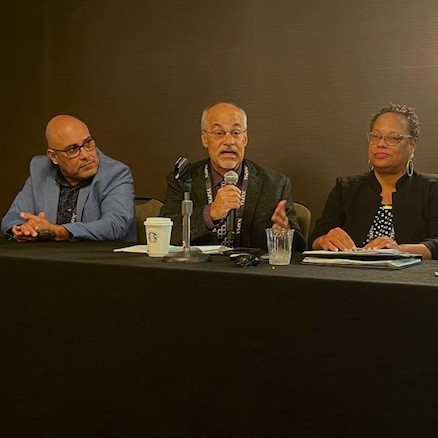Not long ago, the Commonwealth of Virginia knew very little about the court outcomes of people accused of crime. That has begun to change. Today, the Pretrial Data Project provides state agencies with a wealth of information that helps local authorities make decisions that keep their communities safer and make the criminal legal system more effective.
“Policymakers, practitioners, and researchers can use the data to help inform policy decisions on the pretrial process,” says Christina Barnes Arrington, senior methodologist for the Virginia State Crime Commission.
Collecting and analyzing pretrial data is essential to understanding the impact of policies and practices on the ground. While many local agencies collect some pretrial data, a state-level effort can produce benefits that are more comprehensive and actionable. Virginia’s project is the result of a unique collaboration between the state and its local jurisdictions. The state’s Criminal Sentencing Commission and Crime Commission crunch the numbers, and the Virginia Department of Criminal Justice Services (DCJS) works with local pretrial services agencies to test new practices and generate statewide data that informs good policy.
“This project took an unprecedented level of cooperation across Virginia’s criminal justice systems. It required buy-in from all three branches of government—legislative, executive, and judicial.”
Christina Barnes Arrington, senior methodologist, Virginia State Crime Commission
Developing the Data
In 2017, the Virginia legislature directed the state’s Crime Commission to conduct a study reviewing the pretrial process. Lawmakers wanted to learn basic facts about individual outcomes for people in the pretrial system, as well as about community safety—such as the rates at which people were released pretrial, appeared for their court dates, or remained arrest-free.
To conduct the study, the Crime Commission worked with the Sentencing Commission, sending surveys and gathering data from stakeholders across the pretrial system, including magistrates, judges, prosecutors, defense attorneys, local jails, police, the Department of Corrections, bail bondsmen, and pretrial service agencies themselves.
The commissions collected data for a cohort of nearly 23,000 adults charged with a criminal offense during a one-month period in October 2017, tracking their progress for the 15 months that followed, by which point most cases would be resolved.
The Crime Commission included a proxy measure of risk for all people included in the study by including calculations based on the Public Safety Assessment (PSA), a validated pretrial assessment tool that estimates the likelihood that people will appear in court and remain arrest-free while on pretrial release. Findings showed that the proportion of released people charged with failure to appear or a new in-state offense punishable by incarceration during the pre-trial period increased as their PSA risk level of failure to appear or new criminal activity increased.
“Our method enabled us to capture and calculate a variety of prior record measures, and also helped us to identify any new arrests during the pretrial period,” says Meredith Farrar-Owens, director of the Sentencing Commission, which now houses the Pretrial Data Project.
At the end of the study period, the Crime Commission created a final report. The findings provide a window into the state’s pretrial process. The vast majority of people were released during the pretrial period—most within the first three days, which research shows is best practice for ensuring that people can maintain employment and family connections. Additionally, the bulk of those released returned to court (86 percent) and remained arrest-free (76 percent). People were detained in only a small percentage of cases. Importantly, people with higher PSA scores were more likely to be detained.
“That’s really the outcome that we’re looking for,” Farrar-Owens says.
Following the publication of the report, the Virginia legislature requested yearly data analysis, which the Sentencing Commission has continued to handle. The agency now maintains a statewide database capturing all pretrial decisions, and today the PSA is being pilot tested in selected jurisdictions.

Local Collaboration
At the local level, pretrial service agencies are using the new data to make better recommendations to judges and track outcomes for people who enter the court system.
Wesley Smallwood is the pretrial services coordinator for DCJS, the state agency that provides funding, guidance, data analysis, and oversight for local pretrial services agencies. One major gap under the previous system, he says, was that many people were coming to arraignment without having undergone an assessment by local pretrial services agencies. Now, with the implementation of the PSA tool, pilot jurisdictions are able to assess everyone in the system.
“In the pilot sites, the early data shows that they have been able to accomplish what we call universal assessment,” Smallwood says. “So they’ve closed the gap.” This change helps agencies provide neutral and objective information to assist judicial officers in making early and appropriate decisions about release or detention.
The pilot of the PSA involved extensive collaborative work across local justice systems and communities. Jurisdictions relied on the findings of the Pretrial Data Project to help them understand their local decisions and begin making data-informed policy decisions similar to those recommended in the APPR’s Roadmap for Pretrial Advancement, such as using citations instead of arrests and creating pretrial diversion programs.
The project’s data dashboard also allows local jurisdictions to understand people’s pretrial outcomes and evaluate their own work. “The role of a pretrial services agency is to provide additional information to the courts for as many people as possible, at the earliest point possible,” Smallwood says. “If agencies are missing a chunk of people who are eligible to receive a pretrial assessment, then they need to find creative ways to work with stakeholders and address barriers.” That could include anything from addressing staffing shortages to seeking better access to people in jail.
Access to the new data has been essential for local agencies’ efforts to improve operations. Steven Austin is the director of Prince William County Criminal Justice Services, a pilot site for PSA implementation that has been working on data gathering for nearly a decade.
Smallwood and DCJS provided training on how to code local data so that it would be more uniform and therefore more helpful to the county—and to researchers like Arrington and Farrar-Owens. “We are collecting tons more data now about how we make our recommendations, whether or not the court is following them, and what the outcomes are,” Austin says.
Prince William County has also used the state-level data dashboard to draw out local information that can be used in tandem with information from the PSA to help determine a person’s risk level and release conditions. In general, Austin says, the shift to using the PSA has made a big difference in his agency’s ability to provide data-driven information to judicial officers to assist them in making more informed pretrial release condition recommendations. Using the old approach, they provided assessment information on around 80 percent of people accused of crimes; using the PSA, it’s 100 percent.
“That’s huge,” Austin says. “When we conduct risk assessments on everyone, it means that everyone has access to fair and equal justice.”
Recently, Prince William County has implemented some new pretrial practices, including providing everyone in the system with an attorney at first appearance, which helps ensure that people receive a release decision immediately and do not have to wait in jail for a bond hearing. The Pretrial Data Project will help determine the impact of this and other emerging practices.
Next steps
This unprecedented interagency collaboration has made Virginia a national leader in pretrial data practice. Other states are now looking to replicate their efforts. Virginia’s team recommends that states start small, check the status of their data systems before beginning collection and analysis, and take the time to clean and code the data.
The Sentencing Commission plans to take on other research topics using the data. In 2021, for example, the state eliminated the presumption to deny bail in certain circumstances, making more people eligible for release. Farrar-Owens wants to study pretrial outcomes after that change.
Overall, Virginia’s data project is about making policy decisions that improve community safety. “In the future, if there are legislative proposals—for example, to make changes to the pretrial system—this data set allows us to assess their potential impact,” Farrar-Owens says. “It is super useful for policy analysis.”
About the Author
Michael Friedrich is a journalist living in Brooklyn, New York, who writes about public policy.






